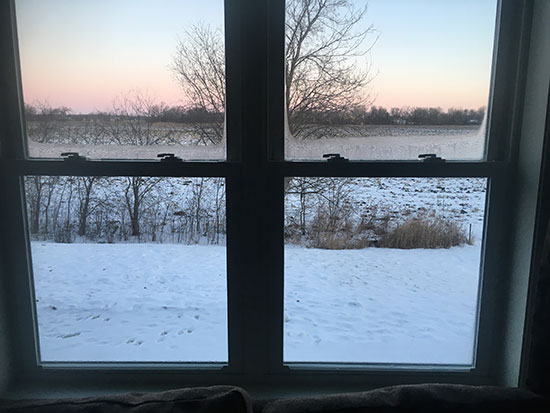
Window Condensation Explained
We all know what window condensation is – we’ve wiped it from windows to look out and see the snow falling outside (or rain, because Wisconsin). Window condensation is most common in winter and comes from the combination of inside temperature, inside relative humidity, and outside temperature. It’s not necessarily because your home is too humid or because your windows need to be replaced and it can be a nonissue. This two-part piece will explain the how and why of window condensation and then provide some insight on how to remedy it.
Minimal moisture on windows isn’t anything to be overly alarmed about. All other things equal, the colder the night, the more condensation you will see, to the point of even icing. This is where we start to be concerned, especially with wood windows or sills. Too much moisture can lead to rot for wood products and mold for all types of windows. And rot and mold are nothing to be happy about, am I right?
The easiest way to explain why the window condensation is happening is to compare it to dew on the grass on summer mornings or taking a drink of your choice out of the fridge on a hot summer day. There is a surface at a given temperature and humidity level and then we shock that surface by putting it in contact with a significantly different temperature with vapor in the air (humidity). The warm grass from sunny and humid day hits a colder-than-normal night and dew (condensation) occurs. The drink comes out of the fridge at 40 degrees and hits the humid, 80-degree air and it sweats. In all these cases, the dew point is met, which forms condensation on the surface. Window condensation happens at night because we are warming the window surface with 70-degree air all day and at night when the outside temperature drops, we push the window outside by drawing blinds or shades and not allowing that 70-degree air to keep the surface warm.

When and where will it happen in your home?
Every home is different, but here is an example of conditions and when window condensation will occur. A 70-degree inside temperature and 40% indoor relative humidity creates a 44-degree dew point, or condensation point. Once the window surface hits 44 degrees inside, the water vapor in the air will turn to liquid. So, if you close blinds and it’s 10 degrees outside, it probably won’t take long for that inside surface to hit 44! Keep in mind that most new windows are in the R3.5 range, so they don’t take long to move in temperature.
If you’ve followed me this far, you might be wondering why window condensation always starts at the bottom of the window and in the corners? So glad you asked! This is the first point of condensation because it’s the most difficult part of the window for heated air to meet and is nearest to the spacers that separate the panes of window glass. These spacers are made in a variety of materials, some conduct the cold outside temperature quicker than others. Trying to get heated air to the glass surface is important to delaying how quickly the bottom edge starts to get wet. Look through our pictures and virtual tours and we bet you’ll see heat vents under many windows; to keep them warm and slow down condensation! Smart design!
There are a few ways to control window condensation and they come from our energy consultants, eFree Advisors. To get these tips, follow our blog and next week's post and see how you can take steps to reduce window condensation in your home!
